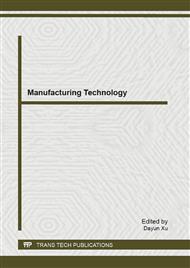[1]
E. Del Castillo, A.M. Hurwitz, Run-to-run process control: literature review and extension, Journal of Quality Technology. 29 (1997) 184-196.
DOI: 10.1080/00224065.1997.11979749
Google Scholar
[2]
E. Del Castillo, Jinn-Yi. Yeh, An adaptive run-to-run optimizing controller for linear and nonlinear semiconductor processes, IEEE Transactions on Semiconductor Manufacturing. 11 (1998) 285-295.
DOI: 10.1109/66.670178
Google Scholar
[3]
E. Del Castillo, A multivariate self-tuning controller for run-to-run process control under shift and trend disturbances, IIE Transactions. 28 (1996) 1011-1021.
DOI: 10.1080/15458830.1996.11770756
Google Scholar
[4]
Z. Du, X. Jin, L. Wu, Fault detection and diagnosis based on improved PCA with JAA method in VAV systems, Building and Environment. 42 (2007) 3221-3232.
DOI: 10.1016/j.buildenv.2006.08.011
Google Scholar
[5]
S.K. Fan, Y. Lin, Multiple-input dual-output adjustment scheme for semiconductor manufacturing processes using a dynamic dual-response approach, European Journal of Operational Research. 180 (2007) 868-884.
DOI: 10.1016/j.ejor.2006.05.003
Google Scholar
[6]
C.H. Jen, B.C. Jiang, Combining on-line experiment and process control methods for changes in a dynamic model, International Journal of Production Research. 46 (2008) 3665-3685.
DOI: 10.1080/00207540601120476
Google Scholar
[7]
C.H. Jen, B.C. Jiang, S.K. Fan, General run-to-run (R2R) control framework using self-tuning control for multiple-input multiple-output (MIMO) processes, International Journal of Production Research. 42 (2004) 4249-4270.
DOI: 10.1080/00207540410001708498
Google Scholar
[8]
J. Moyne, E. Del Castillo, A.M. Hurwitz, Run-to-run control in semiconductor Manufacturing, Boca Raton FL: CRC Press (2001).
DOI: 10.1201/9781420040661
Google Scholar
[9]
T.H. Smith, D.S. Boning, Run by run advanced process control of metal sputter deposition, IEEE Transactions on Semiconductor Manufacturing. 11 (1998) 276-284.
DOI: 10.1109/66.670176
Google Scholar
[10]
S. Tzafestas, K. Watanabe, Modern approaches to system/sensor fault detection and diagnosis, Journal A. 31 (1990) 42-57.
Google Scholar
[11]
S. Yoon, J.F. MacGregor, Fault diagnosis with multivariate statistical models part I: using steady state fault signatures, Journal of Process Control. 11 (2001) 387-400.
DOI: 10.1016/s0959-1524(00)00008-1
Google Scholar
[12]
R.P. Good, S.J. Qin, On the stability of MIMO EWMA run-to-run controllers with metrology delay, IEEE Transactions on Semiconductor Manufacturing. 19 (2006) 78-86.
DOI: 10.1109/tsm.2005.863211
Google Scholar


